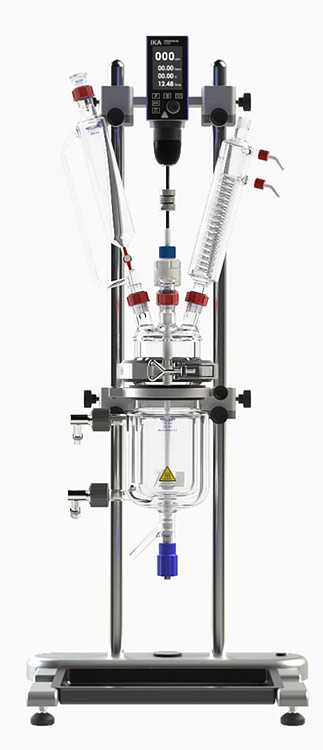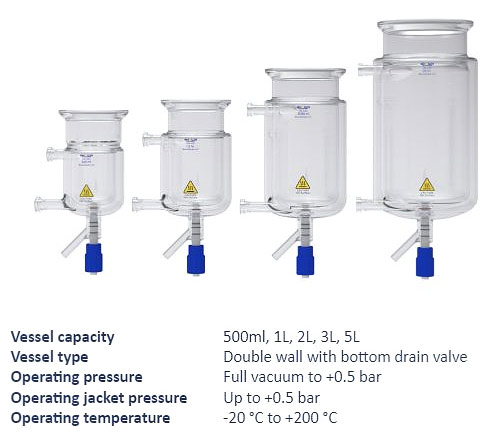Products
Glass Reaction Systems, Labatcher Glass Vessels & Gas Scrubbers
Labatcher
Revolutionize your chemical synthesis and experimentation with our state-of-the-art Laboratory Scale Batch Mode Glass Reactor. Designed for precision, performance, and versatility, this system is the perfect solution for your laboratory needs
Advanced Features :
- Modular Design: Easily customize the reactor setup with various accessories and options, including additional ports, reflux condensers, and in-line sensors for enhanced functionality.
- Real-Time Monitoring: Monitor key parameters such as temperature, pressure, pH, and stirring speed in real time, ensuring optimal conditions for your reactions.
- Data Logging and Analysis: Capture and analyze experimental data with built-in data logging capabilities, facilitating data-driven decision-making and process optimization.
- Compact Footprint: Save valuable laboratory space with our compact and efficient reactor design, ideal for small-scale experiments and research projects.
- Robust Construction: Constructed with durable materials and precision engineering, our reactor system guarantees long-term reliability and performance.
Applications Across Industries :
- Chemical Engineering
- Chemical Research Institutes
- Pharmaceuticals
- Agro and Specialty Chemicals
- Materials Science
- Environmental Research
- Food and Beverage Processing
- Renewable Energy Development
- Biotechnology and Bioengineering

Specifications :
- Nominal volume glass vessel ml: 500, 1000, 2000, 3000, 5000
- Working temperature °C: -20 to + 200
- Glass reactor made of borosilicate 3.3. Double jacket design with bottom drain valve.
- Operating overpressure glass reactor -1 bar or up to +.0.5 bar
- Quick release: Jaw lock can be opened by hand directly below the chassis plate. The chassis plate keeps the reactor centred.
- O-ring seal Viton, Kalrez or EPDM lying in the autoclave vessel.
- Magnetic stirrer head with a torque of 20,40, 60 or 90 Ncm, connected to the laboratory drive via a flexible coupling.
- Agitator drive: IKA, Heidolph, Neuation, CAT etc.
- Valve with immersion tube for sampling and draining.
- Immersion well with temperature sensor Pt100
- Stirring element: Gas flushing stirrer or other can be used.
- Heating: Double jacket for heat transfer oil
- 4-cornered base chassis, height adjustable via the four adjustable feet
- Lifting lowering device for vessel.
Glass Vessels
The vessels of Labatcher are made of high-quality borosilicate 3.3 glass acc. to ISO 3585, which is chemically and thermally highly resistant. Certainly! Glass vessels used in laboratory scale batch mode glass reactor systems typically have several key features that make them well-suited for various chemical processes and experimentation.

- Borosilicate Glass Construction:Glass vessels are typically made from borosilicate glass, known for its excellent thermal and chemical resistance. This type of glass can withstand a wide range of temperatures and is highly resistant to corrosion from acids, bases, and other reactive substances.
- Transparency: One of the primary advantages of glass vessels is their transparency, allowing researchers to visually observe reactions as they occur. This visibility is crucial for monitoring reaction progress, phase changes, and the formation of precipitates or gases.
- Versatile Design: Glass vessels come in various shapes and sizes to accommodate different experimental requirements. Common designs include cylindrical, spherical, and flask-shaped vessels, with options for customized configurations based on specific applications.
- Temperature Control: Glass vessels are compatible with heating and cooling systems, allowing precise temperature control during reactions. This feature is essential for maintaining optimal reaction conditions and achieving reproducible results.
- Stirring Mechanism: Many glass vessels are equipped with integrated stirring mechanisms or ports for attaching stirrers. This ensures thorough mixing of reactants and promotes uniform heat distribution throughout the vessel, enhancing reaction efficiency.
- Chemical Inertness: Borosilicate glass is chemically inert, meaning it does not react with most chemicals. This inertness minimizes contamination and ensures the purity of reactions, making glass vessels suitable for a wide range of chemical processes.
- Easy Cleaning and Maintenance: Glass vessels are relatively easy to clean and maintain, as they can withstand frequent washing, sterilization, and chemical cleaning procedures without compromising their integrity or performance.
- Scalability: Glass vessels used in laboratory scale batch mode reactors are often designed with scalability in mind. This means that the vessel size and configuration can be scaled up for larger production processes while maintaining similar performance characteristics.
- Safety Features: Some glass vessels may include safety features such as pressure relief valves, protective coatings, or reinforced designs to prevent breakage and ensure safe operation under varying conditions.
Gas Scrubber
Gas Scrubber System for lab, pilot plant / kilo lab and production
The purpose of a gas scrubber is to neutralize corrosive exhaust gases from reactors. Depending on what the scrubbing liquid is, the scrubber is capable of neutralizing either caustic or acidic vapors. The scrubbers are equipped with an ETFE lined, corrosion resistant magnetic coupled pump. A built-in reducing valve enables the scrubbing liquid flow rate to be controlled. As the scrubbing liquid is maintained at a certain temperature by a spiral cooler in the liquid circuit, it is possible to control the flow rate.
Applications Across Industries :
- Off-gas treatment
- Neutralizing of exhaust gas
- Stripping
- Scale-up
- Process development

Specifications :
- Mobile gas Scrubber volume: 5L, 10L, 20L, 30L, 50L, 100L
- Stationary gas scrubber volume: Customized according to the process requirements
- Mobile gas scrubber Column diameter: DN50, DN70, DN100, DN150, DN200
- Stationary gas scrubber Column diameter: DN50 upto DN600
- Scrubbing liquid temperature °C: -20 to + 80°C
- Exhaust gas temperature °C: -60°C to +200°C
- Material: Borosilicate 3.3, ETFE, PTFE
- Pressure: -1 bar or up to +.0.5 bar
- Online pH monitoring of scrubber liquid
- Corrosion resistant stainless steel frame
